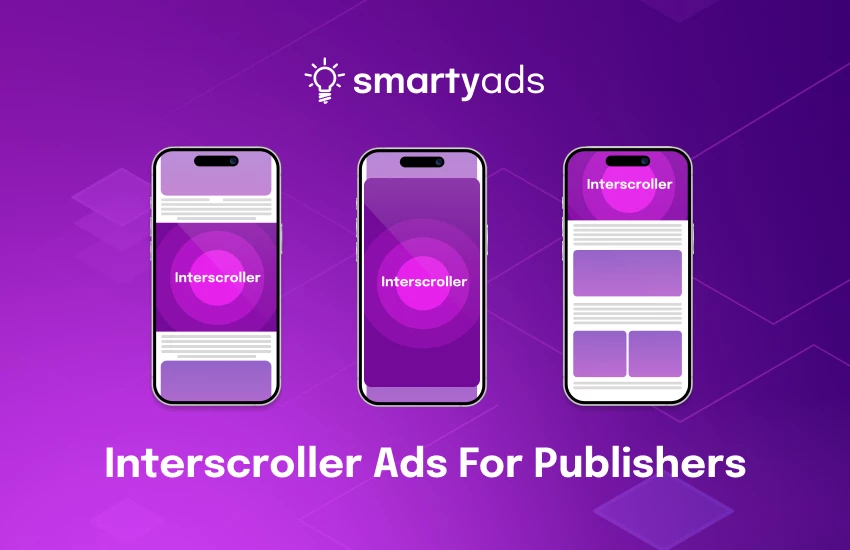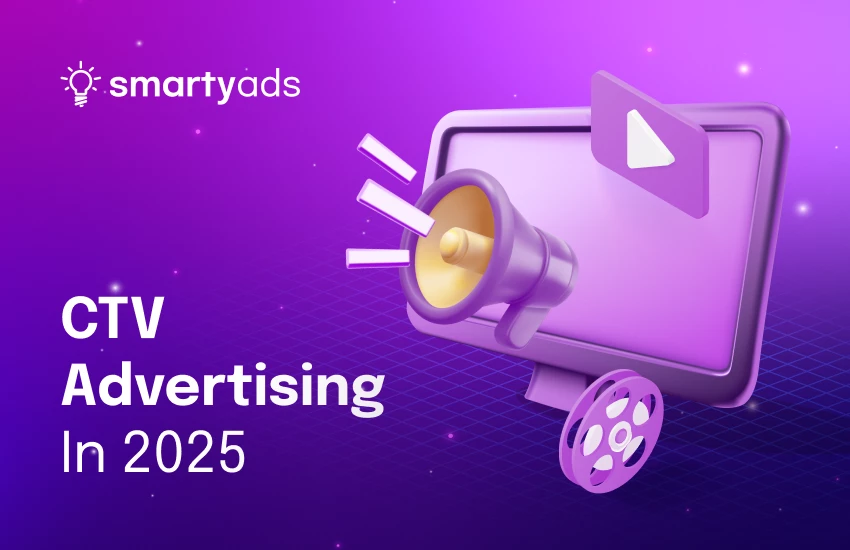Publishers face a straightforward problem. Show too many aggressive ads, and users leave. Show too few, and revenue suffers.
Interscroller ads offer a practical middle ground. They don’t block content like interstitials. They don’t interrupt what users came to read. Instead, they appear as users scroll through the page.
Mobile will accounts for 73% of digital ad spending, and publishers who figure out mobile monetization without destroying user experience see better long-term results. Interscroller ads have consistently performed well in this regard.
What exactly are interscroller ads?
Interscroller ads (sometimes called flying carpet ads) are banner-style advertisements that show up between sections of your content. The difference from regular banners? They activate when users scroll, revealing themselves gradually as part of the page flow.
From a technical angle, it works like this. You place the ad unit within your content stream. When a user scrolls and the ad reaches about 85% visibility, it can expand. This gives advertisers that full-screen moment. But unlike interstitials, users aren’t forced to do anything. They just keep scrolling when they’re ready.
We’ve found this timing is perfect. Users are already engaged with scrolling. Their eyes are on the screen. The ad doesn’t feel like it’s getting in the way. It’s there. It’s visible. But it doesn’t demand immediate attention.
Why we recommend interscroller ads over interstitials
Look, interstitials have been around forever. Advertisers love them because they're well known and cover full screen. But from a publisher's perspective, they come with baggage. We've tracked the data across hundreds of publishers, and the pattern is clear: interstitials drive users away.
Interscroller ads solve this problem without sacrificing revenue. We've watched publishers make the switch and consistently see better results.
Users don't have to dismiss anything. They scroll past the ad when they're done looking at it. This might sound like a small thing, but it's huge for reducing friction. Every extra tap or click is a chance for someone to leave.
The ads blend into your content naturally. We place them at transition points—between paragraphs, after sections—so they feel like part of the page design rather than an interruption. Users expect some ads on free content. They just don't want those ads to block what they came to read.
Loading is faster too. Interscrollers don't trigger a new page load or freeze the screen, so latency drops. We've measured this across different implementations, and the speed improvement is noticeable.
And then there's Google. They've been cracking down on intrusive interstitials for years now, especially on mobile. If your interstitials block content in certain ways, you risk SEO penalties. Interscroller ads don't trigger these penalties because users can still access your content freely.
The revenue side of interscroller ads
When we first started talking to publishers about interscroller ads, the most common question was: "If they're less aggressive, do they make less money?" Fair question. The answer we've consistently seen is no—they often make more.
Voluntary engagement matters more than forced visibility. When users interact with an interscroller ad, it’s because something caught their interest. That leads to better click-through rates and higher conversions. Advertisers notice this. They’re willing to pay more for it.
Viewability scores are strong. The format gradually reveals itself as users scroll. When it hits about 85% visibility, it expands. These are viewability numbers that put interscrollers in premium territory. Advertisers pay more for ads they know will actually be seen.
User retention improves. This has been consistent across every publisher we’ve worked with who made the switch. When you stop frustrating users with pop-ups, they stick around longer. More time on site means more page views. That creates more ad opportunities. The math works out.
Advertisers are increasingly picky about where their brands appear. They want formats that don’t annoy people. Interscroller ads create a better brand association because they respect the user experience. That makes your inventory more attractive to premium buyers. They’re willing to pay top dollar.
Comparing interscroller ads to other formats
We get asked all the time how interscroller ads stack up against other mobile options. Based on what we've seen working with publishers:
Interstitials give you guaranteed visibility, but they hurt user experience. Interscrollers give you high visibility without the damage to retention. If you're thinking long-term, interscrollers usually win.
Standard banners are easy to implement. But they suffer from banner blindness. Interscrollers command more attention because they activate with scroll. Yet they are still far less intrusive than pop-ups.
Native ads blend beautifully with content. But they don’t always have the visual impact advertisers want. Interscrollers give you more prominent placement while still maintaining content flow.
Video ads can be powerful, but they require more bandwidth and user attention. For quick-read content where people are actively scrolling, interscrollers tend to work better.
Most successful publishers we work with don't rely on just one format. They mix it up based on content type and user behavior. Interscroller ads are one tool in the toolkit, but they're a tool that consistently performs well.
What this looks like in practice
We worked with a mobile news publisher running articles that typically run 800-1000 words. Their original setup was pretty standard:
- Banner ad at the top of each article
- A couple of sidebar display ads (though these barely show on mobile)
- Interstitial ad when users navigate between articles
This generated about 3-4 ad impressions per article. Not bad, but they were also seeing a 15-20% bounce rate from that interstitial. People would finish an article, hit the interstitial, and just leave instead of reading more content.
We switched them to interscroller ads. Same banner at the top, but then we placed one interscroller ad after the third paragraph and another one about two-thirds through the article. No more interstitials blocking navigation between articles.
Still getting 3-4 impressions per article, but the bounce rate dropped significantly. Users scrolled through content naturally, saw the ads without feeling blocked, and kept reading. Session duration went up, engagement improved, and advertisers saw better performance metrics. Revenue stayed steady in the short term and actually increased over the next few months as the improved engagement brought in higher-paying demand partners.
How SmartyAds SSP handles interscroller ads
We built interscroller ad support into our SSP because we kept seeing publishers ask for better mobile monetization options. It's now part of our standard mobile advertising toolkit.
Implementation is straightforward. You don't need complex technical setup to get interscroller ads running across your mobile inventory. The format plugs into your existing ad stack without headaches.
We connect you to premium demand. Our relationships with top-tier advertisers and demand sources mean your interscroller inventory gets competitive bids and strong fill rates. We've spent years building these relationships, and publishers benefit from that work.
You get optimization tools to help. Our analytics and reporting let you fine-tune interscroller placement, frequency, and performance. It’s all based on real data. You can test different configurations. Then see what works best for your specific audience.
Interscroller ads work best when they're part of a bigger strategy. Our SSP supports multiple formats, so you can mix and match based on what makes sense for different content types and user behaviors.
Check out our publisher gallery to see interscroller ads and other formats in action. You can see actual examples of how they perform and picture them on your own properties.
Why this matters for mobile publishers
User patience for disruptive ads is at an all-time low. Google is actively penalizing publishers who prioritize aggressive monetization over user experience. The days of throwing up as many intrusive ads as possible and hoping for the best are over.
Interscroller ads represent a smarter approach to mobile monetization. You get the ad visibility that advertisers pay for. You maintain the user experience that keeps people coming back. And you avoid the penalties that can tank your traffic.
We've been in this industry long enough to see trends come and go. Interscroller ads aren't a trend—they're a format that consistently delivers results because the fundamentals make sense. Respect your users, give advertisers real visibility, and use data to optimize performance.
SmartyAds SSP gives you everything you need to make interscroller ads work. The platform, the demand connections, the optimization tools—it's all there. We've helped hundreds of publishers implement this format successfully, and we've learned what works along the way.
Register on SmartyAds SSP and start running interscroller ads that actually perform.




